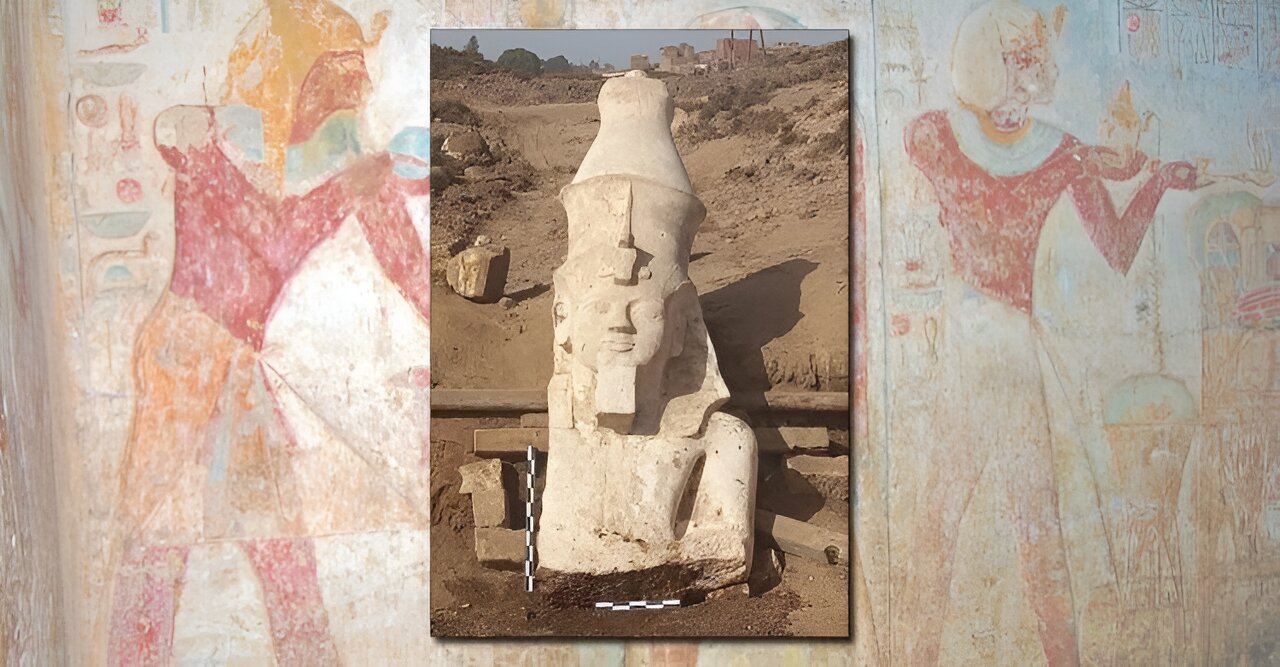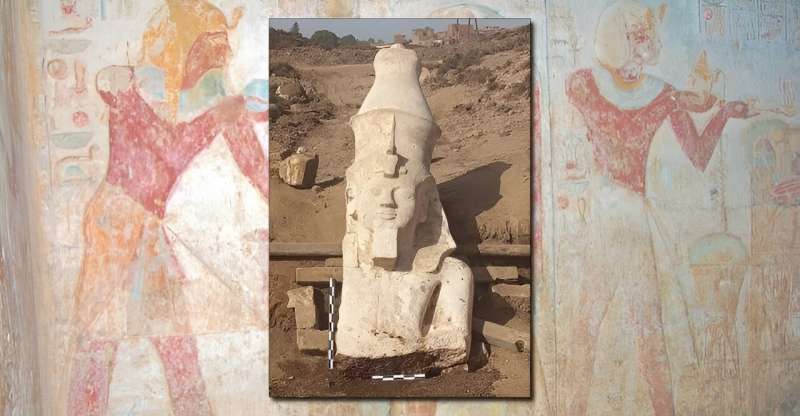

A team co-led by a CU Boulder classics researcher has unearthed the upper portion of a huge, ancient pharaonic statue whose lower half was discovered in 1930; Ramesses II was immortalized in Percy Bysshe Shelly’s “Ozymandias.”
In 1930, German archaeologist Günther Roeder unearthed the lower half of an enormous statue depicting pharaoh Ramesses II, also known as Ramesses the Great, ruler of Egypt some 12 centuries before the common era.
Nearly a century later, an Egyptian–American archaeological team co-led by Yvona Trnka-Amrhein, assistant professor of classics at the University of Colorado Boulder, discovered the upper portion of the enormous statue while conducting research in the ruins of the ancient city of Hermopolis, about 150 miles south of Cairo.
The 12.5-foot-long upper half depicts the pharaoh seated and wearing a double crown and headdress topped with a royal cobra. The researchers determined that the complete statue would have stood approximately 23 feet tall when it was erected.
“We knew it might be there, but we were not specifically looking for it,” says Trnka-Amrhein, who teamed up with Basem Gehad, an archaeologist with the Egyptian Ministry of Tourism and Antiquities. “It was plausible that the rest of the statue might be there, but it was a total surprise. … Getting the text was amazing.”
Trnka-Amrhein, a specialist in papyri whose Ph.D. dissertation at Harvard University examined a “mostly lost Greek novel” about a pharaoh, had been eager to conduct research in Egypt since researching them at Oxford University as a graduate student.
In 2022, Gehad offered her access to conduct research on a papyrus that turned out to be 98 lines containing “substantial excerpts” of two lost works by Greek playwright Euripides. She soon brought in CU Boulder Classics Professor John Gibert, a specialist in tragedy, to continue research on that unusual find.
After the two met, Gehad asked her to co-lead a team of field researchers at Hermopolis. Gehad submitted a proposal and obtained all the necessary permissions to begin work at the site. Theirs was the first major excavation at the site since one led by the British Museum in the 1980s.
“Hermopolis is the second-most productive site for Greek papyri,” Trnka-Amrhein says. “In addition to research, our goal is to preserve the site and make it a viable part of the Egyptian economy.”
Clues to Egypt’s history
Trnka-Amrhein was in the United States awaiting the birth of a child when the piece was discovered in a face-down position in January. She and her teammates were thrilled but had to temper their excitement pending further excavation.
“One problem with Hermopolis is that it’s close to the Nile (River). After (the building of) the Aswan Low Dam, the water table became a huge issue. There was no guarantee that the stone would be OK. Sometimes sandstone is uncovered that is basically just sand or degraded limestone,” Trnka-Amrhein says. “It could have just been a lump of rock.”
Additional excavation revealed that the pharaonic face was remarkably well preserved. The team even found traces of ancient blue and yellow pigment that can be analyzed to deepen their understanding of the time period and the circumstances of the statue’s creation; Gehad specializes in paintings of the Greco-Roman period.
“It will be quite exciting to have a scientific analysis of the pigment,” Trnka-Amrhein says, noting that soil mixed in with the paint will also be scrutinized for clues to Egypt’s history.
Ramesses II is one of the few Egyptian pharaohs widely known to non-experts in the Western world. He was the inspiration for Percy Bysshe Shelley’s famous poem, “Ozymandias,” was played by Yul Brynner in Cecil B. DeMille’s movie The Ten Commandments and voiced by actor Ralph Fiennes in the animated movie “The Prince of Egypt.”
The lower half of the statue remains at the site and Gehad has submitted a proposal to reunite the two pieces, which Trnka-Amrhein expects will be approved. It’s uncertain what would happen to a reassembled statue, but it would likely remain at the site or be placed in a museum, she says.
In the meantime, the team continues intensive study of the piece, and she hopes they will publish a paper on their work sometime this year. Trnka-Amrhein says she hopes to involve more CU Boulder graduate students in the project as it proceeds.
“I came to CU after finishing my Ph.D. because the Classics Department is a really great place where everyone is willing to think outside the box; it’s less canonical than typical classics departments,” she says. “I love Homer and Virgil, but it’s fun to do other things, too.”
Provided by
University of Colorado at Boulder
Citation:
Archaeologists unearth top half of statue of Ramesses II (2024, April 25)
retrieved 25 April 2024
from https://phys.org/news/2024-04-archaeologists-unearth-statue-ramesses-ii.html
This document is subject to copyright. Apart from any fair dealing for the purpose of private study or research, no
part may be reproduced without the written permission. The content is provided for information purposes only.

